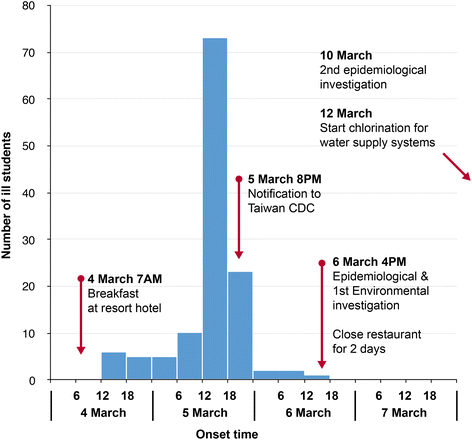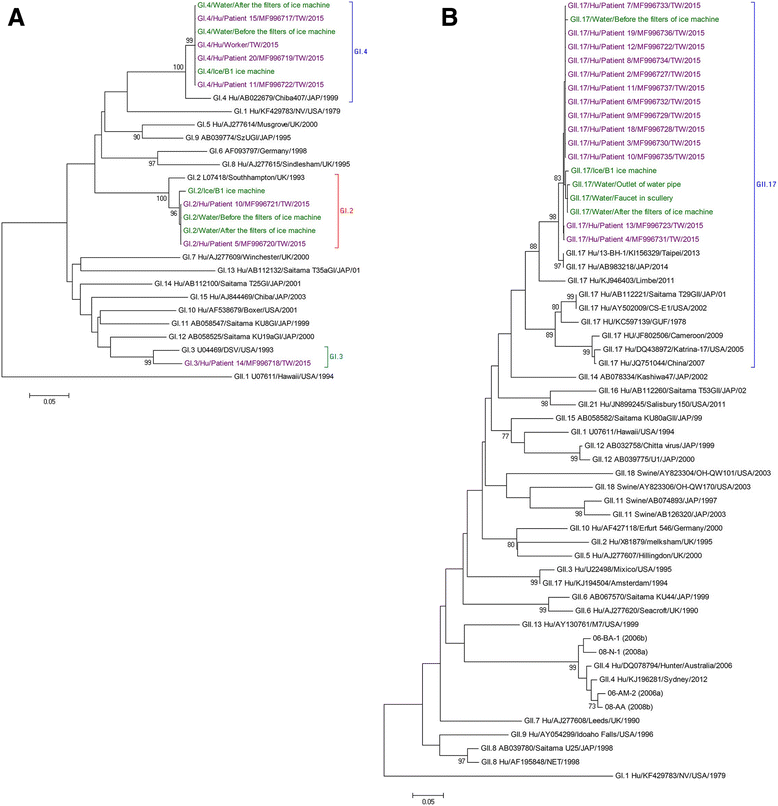Ice-associated norovirus outbreak predominantly caused by GII.17 in Taiwan, 2015
- PMID: 29116002
- PMCID: PMC5688813
- DOI: 10.1186/s12889-017-4869-4
Ice-associated norovirus outbreak predominantly caused by GII.17 in Taiwan, 2015
Abstract
Background: On 5 March 2015, Taiwan Centers for Disease Control was notified of more than 200 students with gastroenteritis at a senior high school during excursion to Kenting. We conducted an outbreak investigation to identify the causative agent and possible vehicle of the pathogen.
Methods: We conducted a retrospective cohort study by using a structured questionnaire to interview all students for consumed food items during their stay at the resort. Students were defined as a gastroenteritis case while having vomiting or diarrhea after the breakfast on 4 March. We inspected the environment to identify possible contamination route. We collected stool or vomitus samples from ill students, food handlers and environmental specimens for bacterial culture for common enteropathogens, reverse transcription polymerase chain reaction (RT-PCR) for norovirus and enzyme-linked immunosorbent assay (ELISA) for rotavirus. Norovirus PCR-positive products were then sequenced and genotyped.
Results: Of 267 students enrolled, 144 (54%) met our case definition. Regression analysis revealed elevated risk associated with iced tea, which was made from tea powder mixed with hot water and self-made ice (risk ratio 1.54, 95% confidence interval 1.22-1.98). Ice used for beverages, water before and after water filter of the ice machine and 16 stool and vomitus samples from ill students were tested positive for norovirus; Multiple genotypes were identified including GI.2, GI.4 and GII.17. GII.17 was the predominant genotype and phylogenetic analyses showed that noroviruses identified in ice, water and human samples were clustered into the same genotypes. Environmental investigation revealed the ice was made by inadequate-filtered and un-boiled water.
Conclusions: We identified the ice made by norovirus-contaminated un-boiled water caused the outbreak and the predominant genotype was GII.17. Adequately filtered or boiled water should be strongly recommended for making ice to avoid possible contamination.
Keywords: GII.17; Gastroenteritis; Ice; Norovirus; Outbreak; Water borne.
Conflict of interest statement
Ethics approval and consent to participate
This outbreak investigation was reviewed by Taiwan CDC and approved as part of the legally authorized mandate. It was therefore considered a minimal risk research, which was exempted from human subject review and does not require informed consent. The authors assert that all procedures contributing to this work comply with the ethical standards of the relevant national and institutional committees on human experimentation and with the Helsinki Declaration of 1975, as revised in 2008.
Consent for publication
Not applicable.
Competing interests
The authors declare that they have no competing interests.
Publisher’s Note
Springer Nature remains neutral with regard to jurisdictional claims in published maps and institutional affiliations.
Figures


Similar articles
-
Gastroenteritis outbreaks caused by Norovirus genotype II.7 in a college in China (Zhuhai, Guangdong) in 2011.Foodborne Pathog Dis. 2013 Oct;10(10):856-60. doi: 10.1089/fpd.2013.1519. Epub 2013 Jul 10. Foodborne Pathog Dis. 2013. PMID: 23841656
-
An Outbreak of Gastroenteritis Associated with GII.17 Norovirus-Contaminated Secondary Water Supply System in Wuhan, China, 2017.Food Environ Virol. 2019 Jun;11(2):126-137. doi: 10.1007/s12560-019-09371-7. Epub 2019 Feb 9. Food Environ Virol. 2019. PMID: 30739247 Free PMC article.
-
An outbreak of norovirus gastroenteritis associated with asymptomatic food handlers in Kinmen, Taiwan.BMC Public Health. 2016 May 4;16:372. doi: 10.1186/s12889-016-3046-5. BMC Public Health. 2016. PMID: 27143036 Free PMC article.
-
The dynamics of norovirus outbreak epidemics: recent insights.Int J Environ Res Public Health. 2011 Apr;8(4):1141-9. doi: 10.3390/ijerph8041141. Epub 2011 Apr 15. Int J Environ Res Public Health. 2011. PMID: 21695033 Free PMC article. Review.
-
Vomiting Larry: a simulated vomiting system for assessing environmental contamination from projectile vomiting related to norovirus infection.J Infect Prev. 2014 Sep;15(5):176-180. doi: 10.1177/1757177414545390. J Infect Prev. 2014. PMID: 25419239 Free PMC article. Review.
Cited by
-
Food Ice Hygienic Quality Investigation from Public and Collective Catering.Foods. 2025 Mar 26;14(7):1146. doi: 10.3390/foods14071146. Foods. 2025. PMID: 40238252 Free PMC article.
-
Virucidal Activity of Lemon Juice Against Feline Calicivirus, Surrogate of Norovirus.Antibiotics (Basel). 2025 Mar 7;14(3):273. doi: 10.3390/antibiotics14030273. Antibiotics (Basel). 2025. PMID: 40149084 Free PMC article.
-
A foodborne acute gastroenteritis outbreak caused by GII.P16-GII.2 norovirus in a boarding high school, Beijing, China: a case-control study.BMC Res Notes. 2018 Jul 3;11(1):439. doi: 10.1186/s13104-018-3532-1. BMC Res Notes. 2018. PMID: 29970134 Free PMC article.
-
Natural Host-Environmental Media-Human: A New Potential Pathway of COVID-19 Outbreak.Engineering (Beijing). 2020 Oct;6(10):1085-1098. doi: 10.1016/j.eng.2020.08.010. Epub 2020 Sep 5. Engineering (Beijing). 2020. PMID: 33520330 Free PMC article.
-
Prevalence, Distribution, and Genotypes of Adenovirus and Norovirus in the Puzi River and Its Tributaries and the Surrounding Areas in Taiwan.Geohealth. 2021 Dec 1;5(12):e2021GH000465. doi: 10.1029/2021GH000465. eCollection 2021 Dec. Geohealth. 2021. PMID: 34977444 Free PMC article.
References
MeSH terms
Substances
LinkOut - more resources
Full Text Sources
Other Literature Sources
Medical
Miscellaneous

